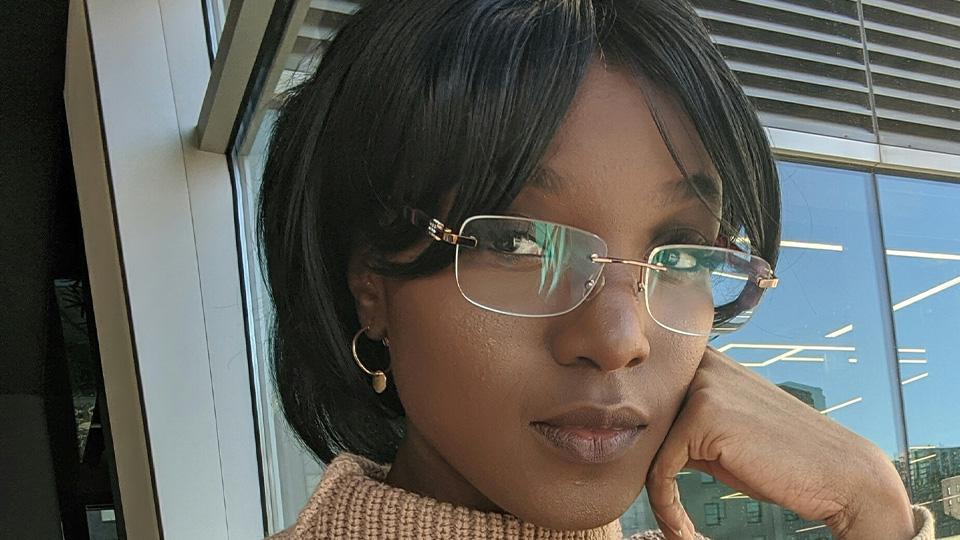Developing worlds: Goldsmiths’ Metaverse explorer
Primary page content
Tara Collingwoode-Williams from Goldsmiths, University of London shared her thoughts on the future of Virtual Reality at this year's Develop Brighton conference.

Tara Collingwoode-Williams
Tara, a lecturer in computing and PhD student in Intelligent Games/Game intelligence (iGGi), focuses on Avatar Embodiment and Interaction within Virtual Reality.
Goldsmiths is one of four Universities involved in the EPSRC Centre for Doctoral Training in iGGi, the world’s largest programme in games research. Representing iGGi, Tara delivered her session Get Immersed! Virtual Humans in Training and Collaboration in Virtual Reality at the Develop Brighton conference on 12 July, 2022.
We caught up with Tara after the conference to discover more about her research and what the future of the Metaverse and extended reality could look like…
Lizzie Ellis: What led you to focus on your current research on Avatar Embodiment and Interaction within Virtual Reality, and why do you think this is an important area to explore?
Tara Collingwoode-Williams: I have always been a huge fan of narrative-based character-driven games, such as L.A Noire, Life Is Strange, and the Final Fantasy series. It can be fun to explore different perspectives and become someone else, but it can also be highly informative in terms of understanding the sense of self and some dynamics of social interaction. Embodiment in Virtual Reality (VR) offers a way of experiencing the first perspective on a much more intimate and immersive level. I wanted to explore the technical requirements of unlocking that phenomena and what psychological impacts it may have.
This is important as we are living in a digital age, and more of our communication is taking place online and in virtual settings - encouraged more with headsets becoming more accessible in terms of price. In VR, due to Embodiment, we can have more understanding over the impact of our representation.
So, we must ask what technical setups can allow us to take ownership and advantage of our representation in virtual platforms; for connecting with others, or for training and learning? What needs to be consistent between users and our real selves? What impact evolves from inconsistencies in representation, or does it all depend on social context? These are important dynamics that we need to explore to create successful immersive experiences.
LE: What does your research tell us about the best ways to use virtual humans in virtual reality training and collaboration?
TCW: This is still an ongoing research exploration. From a collaborative gaming standpoint, recent results do suggest that consistent setups (in terms of same representation and sensorimotor contingencies) of Embodiment produce higher levels of subjective trust and productivity, in line with previous research.
My current project is looking at how specific techniques of Embodiment can have an impact on medical communication training and assessment. One of the crucial factors in setting up a virtual human for this is plausibility. The outcome of learning is dependent on provoking real responses from users therefore, for example, if the communication with the virtual human does not map to a plausible experience (i.e. of having a consultation with a patient) in real life then there cannot be a transfer of skills from VR to real life. But unfortunately, I can’t say much about this project yet… Stay tuned!
LE: What do you see as the most exciting aspect of the Metaverse?
TCW: The next iteration of headsets will include technology such as lip and gaze tracking which will enable us to have more authentic and expressive interactions with one another in VR! Additionally, is content creation - I love that we users are being provided the tools to create worlds and experiences that we can share with others.
People are using these ‘micro-metaverses’ such as Roblox to create spaces to host social events and meetings, build, sell and explore new worlds. It will be the users that will shape what the Metaverse will look like and expand into. It’s best to think about it as building a community. The challenge (amongst so many others,) will be to work out how the value of user-created content translates across different platforms, according to Matthew Ball’s Metaverse Primer, the Metaverse will contain content created by contributors, and offer unprecedented interoperability of data and assets. Nevertheless, other crucial and exciting factors of course can only reveal themselves with time.
LE: What have you found are the greatest barriers to diversity and inclusion in virtual reality environments?
TCW: I think there is much work to do to enable users with disabilities suitable physical access and the same interaction capabilities as their peers in VR. Additionally, more content that reflects diverse understandings of identity, whether that be gender, nationality and culture. I feel these elements could bring us opportunities to understand one another.
Additionally, in the moderation of these platforms, some Metaverses are adopting a decentralised platform approach – meaning they are built and established by communities. But are they governed by a diverse mix of users? This could also impact resolutions and regulations set. I could go on and on. There is a lot to unpack with this question.
LE: How can we ensure that representations in virtual spaces are more inclusive and diverse moving forwards?
TCW: I Like this quote by Jeff Nelson from Blavity: “When you don’t have people at the table who have historically suffered harms or abuses, or who have to live with certain things in the back of their mind, then you don’t build platforms in a way that protects those people.” I agree. One thing that we can do is to make sure there are diverse voices as part of the conversation. Everyone has a story, and it can inform the way in which we interact and represent users in these spaces.